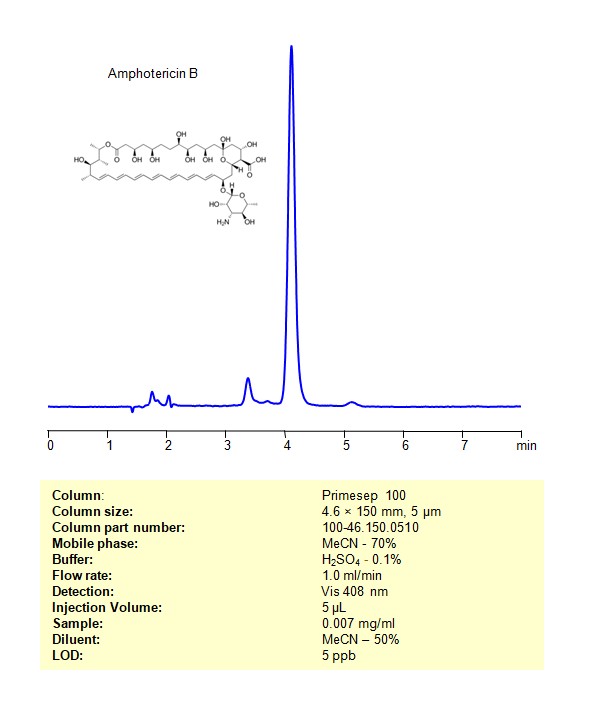HPLC Method for Analysis of Amphotericin B on Primesep 100 Column
Separation type: Liquid Chromatography Mixed-mode SIELC Technologies

High Performance Liquid Chromatography (HPLC) Method for Analysis of Amphotericin B
Amphotericin B is an antifungal medication used to treat serious fungal infections. It belongs to the polyene class of antifungal drugs and is known for its broad-spectrum activity against a variety of fungi. Here are key points about Amphotericin B:
Amphotericin B works by binding to ergosterol, a component of fungal cell membranes. This binding disrupts the integrity of the fungal cell membrane, leading to leakage of cellular contents and ultimately causing cell death.
Amphotericin B is effective against a broad spectrum of fungi, including Candida species, Aspergillus species, Cryptococcus neoformans, and various molds and dimorphic fungi.
It’s important for healthcare professionals to carefully weigh the potential benefits and risks of using Amphotericin B, considering the severity of the fungal infection and the patient’s overall health. As with any medication, it should be administered under the supervision of a qualified medical professional.
Amphotericin B can be retained and analyzed using a Primesep 100 mixed-mode stationary phase column. The analysis employs an isocratic method with a simple mobile phase comprising water, acetonitrile (MeCN), and sulfuric acid as a buffer. This method allows for detection using Vis at 408 nm
| Column | Primesep 100, 4.6 x 150 mm, 5 µm, 100 A, dual ended |
| Mobile Phase | MeCN – 70% |
| Buffer | H2SO4 – 0.1% |
| Flow Rate | 1.0 ml/min |
| Detection | Vis 408 nm |
| Samples | 0.007 mg/ml in MeCN/H2O – 50/50% |
| Injection volume | 5 µl |
| LOD* | 5 ppb |
| Class of Compounds | Drug |
| Analyzing Compounds | Amphotericin B |
Application Column
Primesep 100
Column Diameter: 4.6 mm
Column Length: 150 mm
Particle Size: 5 µm
Pore Size: 100 A
Column options: dual ended





